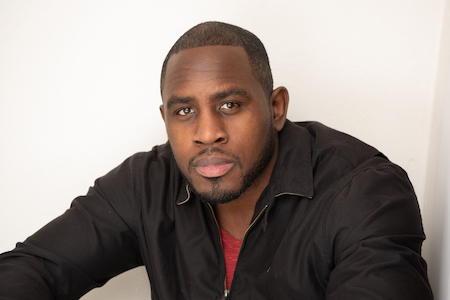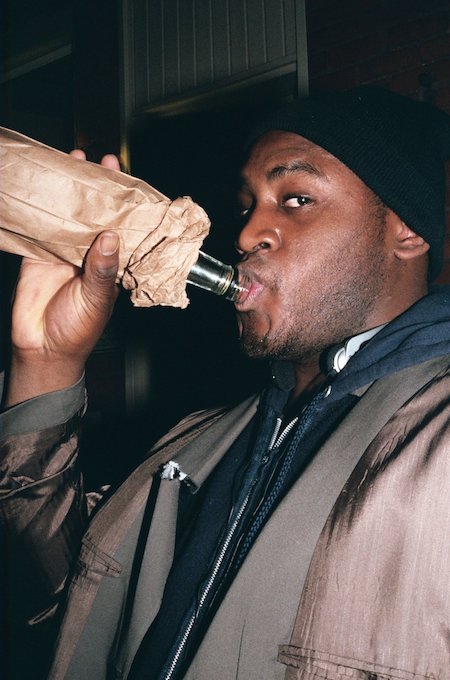So you’ve been thinking about getting a hair transplant.
Well, I’ve had two Follicular Unit Extraction (FUE) hair transplants for a total of a little over 3200 hair grafts.
If you’re losing hair and thinking about a hair restoration procedure (FUE or FUT), then make sure you read this article before you go through with it.
I tell you what to expect, how much it costs, and I show you some before and after pictures so you can see the magic of hair transplantation for yourself. If you’re looking how to stop hair loss early, then read my solutions to hair loss.
The Depression And Embarrassment Of Hair Loss
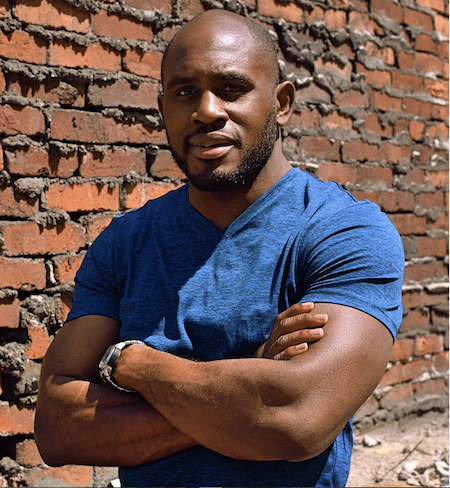
You’re not even 30 years old, and you notice that your temple and crown are starting to disappear, making you look old, sick, and ugly. It feels like out of nowhere, your hair just vanished.
You are not alone.
The American Hair Loss Association reports the following:
By the age of thirty-five two-thirds of American men will experience some degree of appreciable hair loss, and by the age of fifty approximately 85% of men have significantly thinning hair. Approximately twenty-five percent of men who suffer from male pattern baldness begin the painful process before they reach the age of twenty-one.
To put that in perspective, 1 in 4 guys will start balding while they’re still in college!
I didn’t start losing my hair that early, but you can’t outrun your genetics.
Though I kept my hair cut low in my early twenties to hide the thinning I was already experiencing, I’ll never forget the day after I’d let my hair grow out a little longer than usual, that a friend exclaimed, “You’re balding dude!”
It wasn’t said as a joke or a taunt, but it still cut me. It was at that moment that I started researching solutions. Minoxidil and finasteride are the only two FDA approved treatments for hair loss, so I tried them out.
For a while, I used the two together. I got ok results, but it was a hassle to remember to do it every day. Especially when it takes up to a year to really see the effects of these drugs on your crown and hairline.
Although both of these hair loss treatments are cheap and effective, they weren’t a good fit for my needs because they couldn’t provide me with the growth I wanted to achieve.
Minoxidil and Finasteride
A minority of men may experience regrowth using minoxidil and finasteride, but in the majority of men, these drugs simply halt hair loss. Any “regrowth” that you see is the result of more hairs remaining in the Anagen (growth) hair phase rather than prematurely entering the Telogen (resting - after shedding) hair phase.
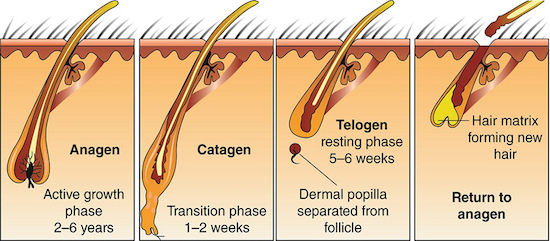
This is great if you catch it early, but if you’re in denial or lazy, then there won’t be much left to salvage by the time you start.
The second problem is that you have to take the drugs every day or lose the benefits.
I won’t dive into the science here, but minoxidil works by stimulating hair growth, and finasteride works by reducing the DHT levels in your body. Miss one day and your hair follicles stop being stimulated and your DHT levels rise back to levels that cause hair loss.
When I started loosing my hair, platelet rich plasma (PRP) or laser cap technology wasn’t commercially affordable, but their available now. That took me to the third solution.
The one the rest of this article will discuss. Hair transplant surgery.
How Surgical Hair Restoration Works
I’ll keep this section short. I’m not a medical doctor and in no way should anything I say (or have said) in this article be taken as medical advice.
I’m damn sure not a hair transplant surgeon. I just made sure that I did my research and asked a lot of questions at my consultation.
Dihydrotestosterone (DHT) is a sex hormone.
Your levels of DHT naturally rise as you get older, but then levels off after a certain point. In a large number of men, the hair follicles in the front and on the crown of the head are sensitive to DHT. In these men, those hair follicles shrink in response to DHT, and eventually, the hairs stop growing.
The hairs on the side and back of the head are forever immune to DHT. They will never experience thinning. It is from this “donor area” that “hair grafts” are transplanted to the balding areas of your scalp.
These hairs are permanent. They will fall never out.
FUT or FUE Style Hair Transplant?
There are two types of hair transplantation methods:
- Follicular Unit Transplantation (FUT). The hair transplant surgeon removes a strip of your scalp from the donor area. The hair grafts are harvested from that strip and then transplanted into the thinning areas of the scalp.
- Follicular Unit Extraction (FUE). Individual hair grafts are removed one by one from the side and back of the head using a specialist micro surgical needle, then transplanted to the thinning areas of the scalp.
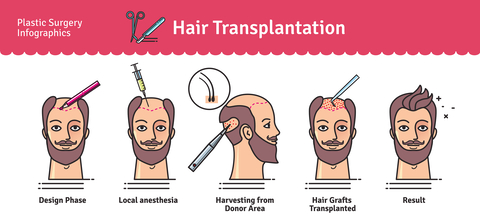
FUT leaves a scar where the strip of your scalp is removed. FUE is more expensive, but there is almost no scarring.
FUE is the way I was advised to go. FUT wasn’t even presented as an option. I’d done some research beforehand and knew that I didn’t want FUT anyway.
My Hair Transplant Story
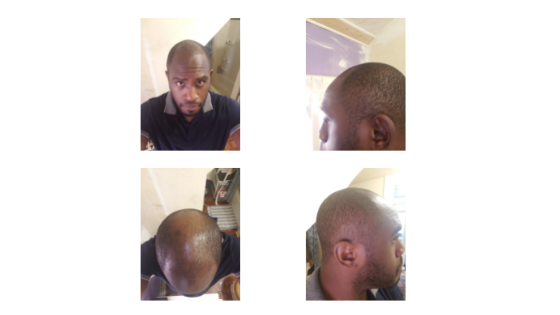
I stopped in the Bosley office nearest me and got a consultation. They took some photos, then sent it to the doctor who’d be performing the surgery.
Initially, I was told that they’d be able to achieve a good effect by transplanting 2500 hair grafts. However, after the doctor looked at my hair texture, he recommended that I have two procedures.
This is a great explanation of what exactly a hair graft is. If you don’t read through, the basic idea is this: a graft is any piece of tissue. A hair graft is a piece of tissue that hairs grow from, taken from your scalp. Each graft contains 2-4 hair follicles.
Apparently, African-American hair is more difficult to extract and preserve the integrity of hair graft, but fewer grafts are required to achieve the desired hair density.
In September of 2018, I had my first hair transplant. They transplanted 1700~ grafts to my hairline and temples.
In June of 2019, I had my second hair transplant. They transplanted 1600~ grafts to my crown with slight reinforcement of my hairline.
The cost of the Bosley FUE hair transplant
They both cost about $9k separately, for a total of about $18k.
I don’t know about all places that perform hair transplant procedures, but Bosley offered financing through a third-party.
It’s not my place to tell you what you should and shouldn’t spend your money on, but I strongly recommend you not let your vanity exceed your spending power.
What is the hair transplant procedure like?
I traveled to the office of Dr. Gabriel Krenitsky in Columbus, Ohio. This was about a 3-hour drive from my home in Pittsburgh, PA.
The procedure started bright and early at 7 a.m., so I got in the night before and stayed at a hotel.
Once there, the doctor comes in, goes over everything with you, and you’re offered a Xanax to keep you calm. After the lines are drawn for where he’ll transplant the hair, the fun begins.
First, one of the nurses numbs the donor area with a local anesthetic. If any part of the procedure is painful or uncomfortable, this is it. I’m not gonna lie: this hurts like hell. The nurses told me that they’ve had guys decide they didn’t want to go through it after a few pokes of the needle.
They have to shoot your scalp multiple times to make sure that your scalp is numb enough so that you don’t feel the microsurgical needle removing each hair graft. I didn’t think it was that bad, but it’s by no means something you can sleep through. It felt way worse on my first procedure than my second. Maybe I was just used to it.
After your donor site is numb, they begin removing the grafts from the donor site area. This portion of the procedure required me to lay face down for about 3 hours. I personally couldn’t fall asleep, but I can see how someone easily could at this stage.
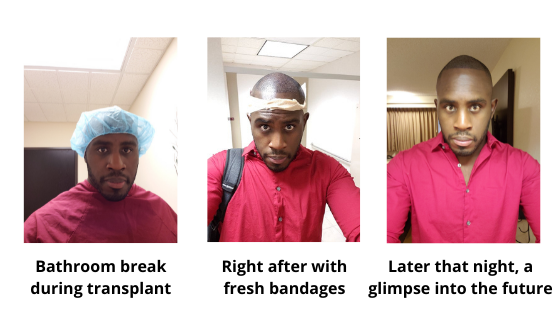
They remove the grafts across a dispersed area, so you don’t have a bald spot in the back of your head. Once they finished removing the grafts, we took a break for lunch.
After lunch, the local anesthesia was this time applied to the top of my head. This was about as painful as the donor site area anesthesia, but once it starts working, you don’t feel anything.
Dr. Krenitsky then made a few incisions with a scalpel for his staff to place the donor hairs. For this part of the procedure, I sat upright and just watched Netflix the entire time.
The entire procedure went from about 7 a.m. to 4 p.m., with my hour lunch break in between. I’ve heard this is extremely fast, but Dr. Krenitsky is a true specialist in hair restoration. It’s what he’s done since 2002. He’s the guy that other hair transplant surgeons go to when they want work done.
Standard Procedure And Realistic Expectations Following Your Hair Transplant
It takes 7 days before you are fully recovered from the procedure. In the meantime, you can’t touch your hair and you have to sleep on your back. You also can’t exercise or wear anything but a button-down shirt.
This is as much for the protection of the new hair as it is for the healing of the donor site. I was given a care kit, which included:
- Antibiotic ointment to apply to the donor site area. Even with a state-of-the-art FUE hair transplant, there can be scarring if you don’t take care of the donor site. You also want to reduce the risk of infection.
- Saline solution to spray on my new transplanted hair. There was a specific solution for the day and one for the night.
- Special shampoo for when I could finally shampoo my hair.
- Gauze to pat wash my hair after a certain number of days.
- Ibuprofen. One of the potential side effects is pain as you are healing. This will help.
However, after the 7th day, you can get on with life. You can even get a haircut.
You get a glimpse of what your filled hair will look like, but 2-3 weeks after the procedure, the new hair will fall out and you’ll look just like you did before the transplant.
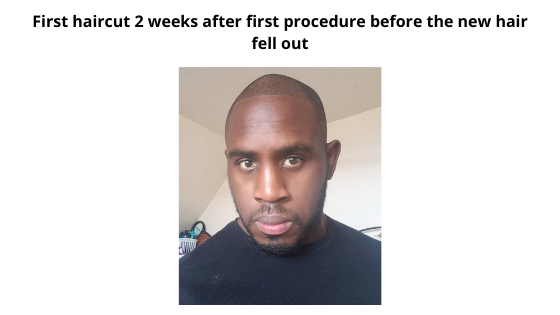
Don’t be alarmed. Those hairs are growing back, but it will take up to a year before the thickness is the same as your original hair.
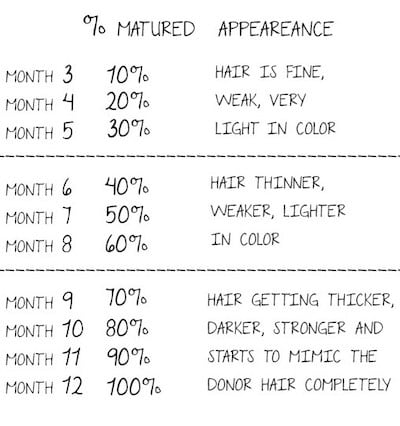
With that said, depending on your ethnicity and hair texture, things can end up looking pretty nice even sooner.
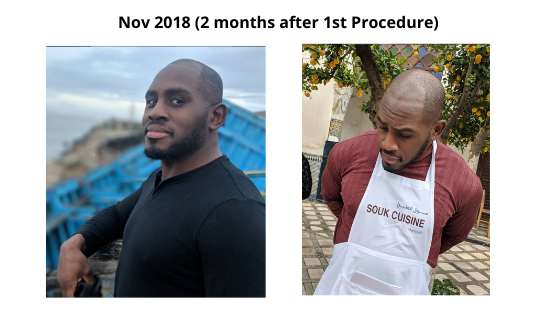
Another Warning About The Hair Restoration Procedure
These transplanted hairs will not fall out, but it is entirely possible for other hair to fall out that was still on the top of your head.
To deal with this, it is recommended that you continue taking minoxidil and finasteride. Dr. Krenitsky recommended I use finasteride, but some of the stories I’ve heard about it freaked me out. Instead, I follow a protocol I created to keep my hair intact my remaining hair in tact—>How to stop hair loss
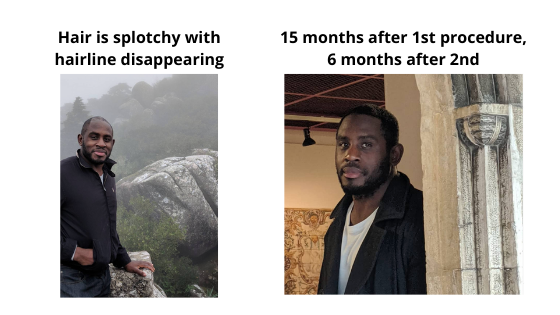
I’m much more vigilant about it now that I have an aesthetic to maintain rather than try to salvage what little I had left.
That doesn’t mean that I’m right and you should take my suggestion. I’m only making sure that you’re aware of this risk. The earlier you are into hair loss, the more likely it is that you’ll need to use minoxidil or finasteride to keep the other hair on the top of your head from falling out.
Should You Get A Hair Transplant?
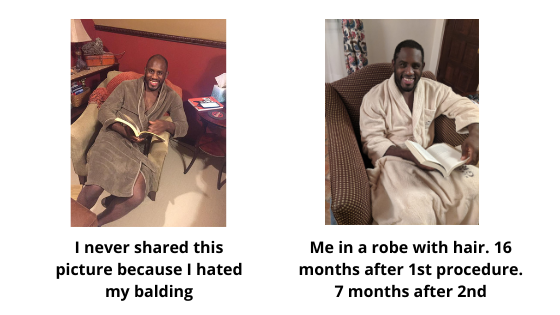
If it’s in your budget, absolutely.
I really can’t recommend it enough.
Just keep in mind that if you’re using it as an alternative to taking minoxidil or finasteride, you may have to continue taking it if your hair loss isn’t advanced enough.
Also, don’t expect to get a full head of hair with perfectly matching thickness. I’m a dark-skinned black man, and if I look hard enough, I can see the density disparity. However, no one can when I wear a regular fade or even haircut.
Your results may vary, which is why it’s important to do research on your doctor and make sure that you feel comfortable. I am very lucky that I lived near Dr. Krenitsky. From his bio on the Bosley website:
Dr. Krenitsky is among only a handful of hair restoration physicians in the country who are recognized as a Diplomate of the American Board of Hair Restoration Surgery. He currently sits on the board of directors of that organization.
Make sure you research your doctor and ask what type of results you can expect for your hair texture, level of hair loss, and skin tone.
If you do all of this, then your hair transplant should be a success!
Having a full head of hair is one thing that makes you an attractive man, read my guide with countless more tips on how to become a more attractive man.


